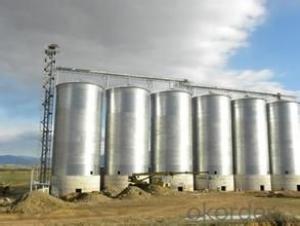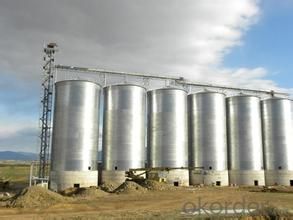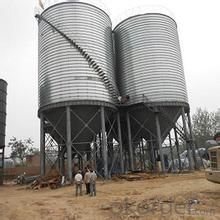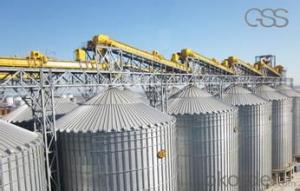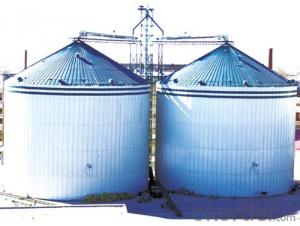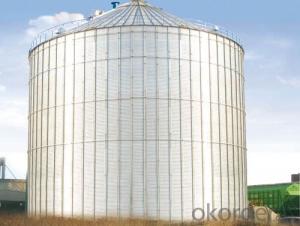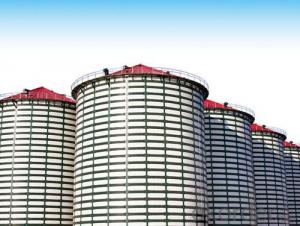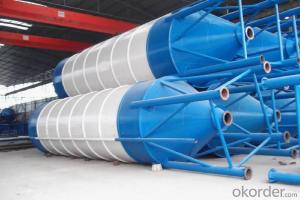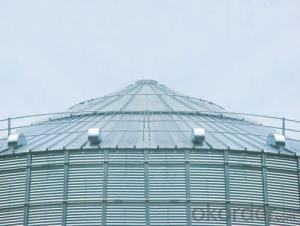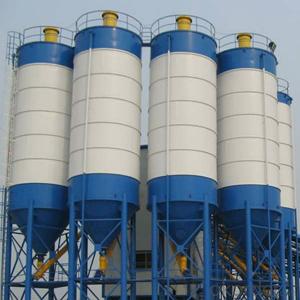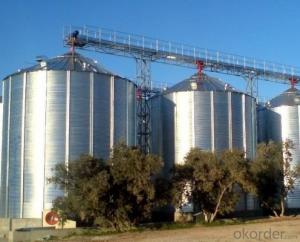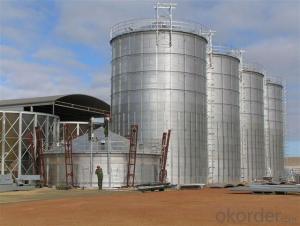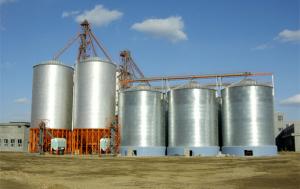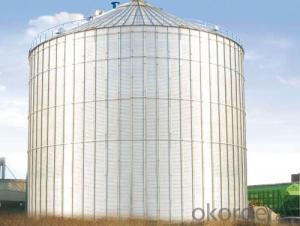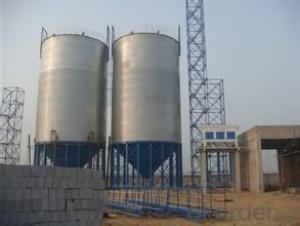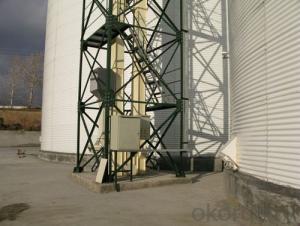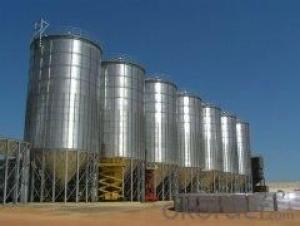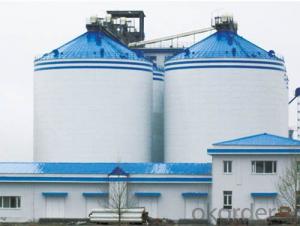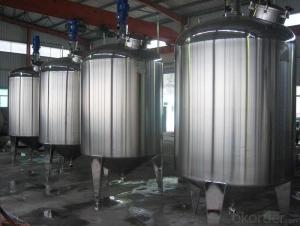Hot dip galvanized flat bottom 5000t wheat silo for sale
- Loading Port:
- Qingdao
- Payment Terms:
- TT OR LC
- Min Order Qty:
- 50 m³
- Supply Capability:
- 50000 m³/month
OKorder Service Pledge
OKorder Financial Service
You Might Also Like
Product Description
Steel Silo Bolt Structure
1. Silo Body
Include the wall plate, column, manhole, roof ladders and so on.
(1) wall plate
Our steel is hot galvanized, which makes it durable and weather resistant. Our advanced bolts with spherical washer and the resisting-worn rubber are used to ensure the tightness and using period.
(2) Column
The column, made by the Z-bar, is used to reinforce the silo body. It is connected by junction panels.
(3) Manhole and Roof Ladders
There are inspection door and ladders inside and outside the silo body. It is convenient and accessible for any maintenance work.
2. Roof
Roof is made up of radiated beam, roof cover board, tension ring, ventilator scoop, roof cap, etc.
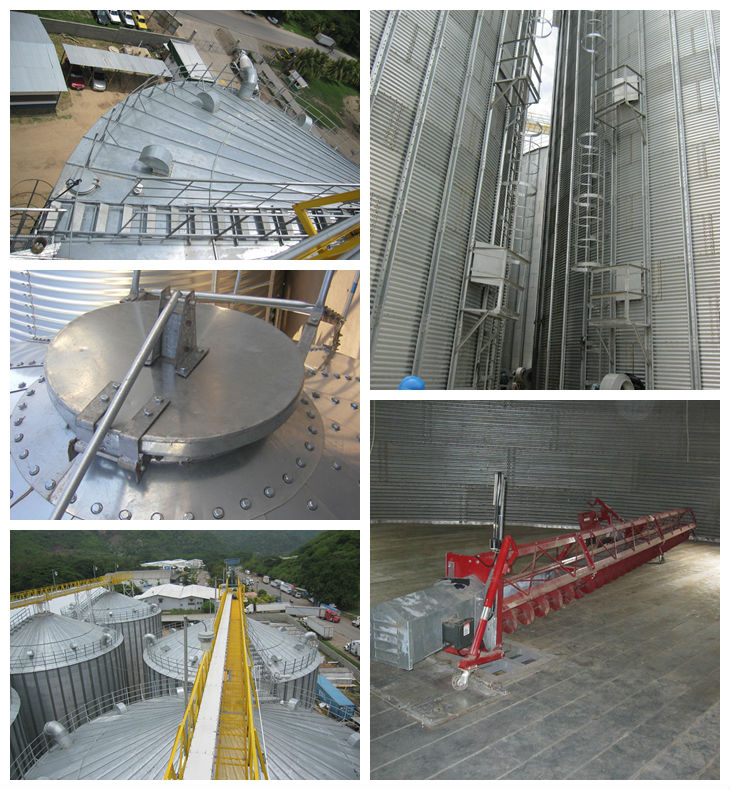
A whole grain storage system
(the following drawing is designed by our sales, our engineer will finally give a design of your needed grain storage system in CAD format after determination )
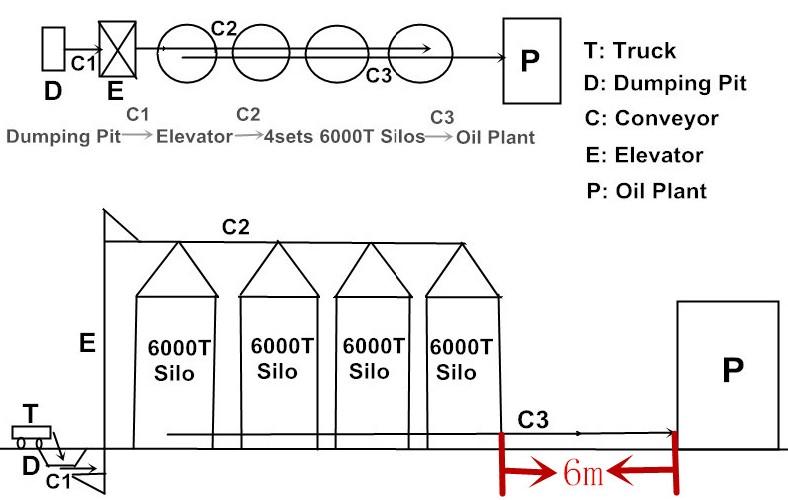
- Q: what is the differences between farm building and farm structure?
- A windmill and many varieties of silos are farm structures, but they are not farm buildings. The same can be said for a two or three sided structure built to be a windbreak for livestock. There are also feeders for livestock that are not buildings, but are structures...racks to hold bales of feed up off the ground, trough systems that deliver food and water, feed mixers are all examples. Also, some farms dig out areas of hillsides/ridges to put silage in and cover them with plastic or tarps to reduce moisture damage...these would be structures and not buildings. Damming a creek to make a pond to water stock would be a farm structure and is clearly not a building. The differences are in the use, complexity of design and materials.
- Q: what does silo images mean?
- Pictures of silos? (I.e., towers where you store grain?)
- Q: what is the storage structure of grains on the large scale known as?
- A Silo or a Grain Elevator.
- Q: What is the most dangerous superhuman power?
- being able to read minds or being invisible
- Q: A silo is to be constructed in the form of a cylinder surmounted by a hemisphere. The cost of construction per square foot surface area is twice as much for the hemisphere as for the cylinder. Determine the dimensions to be used if the volume is fixed (100m^3) and the cost is to be minimum.plz show stepsthanks in advance-lara
- Let V = volume of silo V = volume of hemisphere + volume of cylinder Volume of hemisphere = (2/3)(pi)r^3 Volume of cylinder = (pi)r^2h where r = radius of cylinder = radius of hemisphere h = height of the cylinder Since V = 100, 100 = (2/3)(pi)r^3 + pi(r^2)h and solving for h h = (100/(pi*r^2)) - (2r/3) S = Surface area of silo = surface area of hemisphere + surface area of cylinder Surface area of hemisphere = 2(pi)r^2 Surface area of cylinder = pi(r^2) + 2(pi)rh Therefore, S = 2(pi)r^2 + pi(r^2) + 2(pi)rh since h = (100/(pi*r^2)) - (2r/3) and substituting it in the above equation, S = 2(pi)r^2 + pi(r^2) + 2(pi)r[100/(pi*r^2)) - (2r/3)] Simplifying the above, S = 2(pi)r^2 + [(pi)r^2 + 200/r - 2(pi)r^2/3] S = 2(pi)r^2 + [(1/3)(pi)r^2 + 200/r] Since cost of hemisphere is twice that of the cylinder, then C = cost = 2*2(pi)r^2 + 1*[(1/3)(pi)r^2 + 200/r] C = 4(pi)r^2 + (1/3(pi)r^2 + 200/r C = (13/3)(pi)r^2 + 200/r Differentiating C with respec to r, (dC/dr) = (26/3)(pi)r - 200/r^2 and setting (dC/dr) = 0 and solving for r, (26/3)(pi)r - 200/r^2 = 0 Simplifying the above, 26(pi)r^3 = 600 Solving for r, r = 1.94 meters Now, that r is known, h can be determined by using the above derived formula of h = (100/(pi*r^2)) - (2r/3) Substituting r = 1.94. h = 7.16 meters Dimensions of the silo are: r = 1.94 m h = 7.16 m CHECK: First check: V = (2/3)(pi)(1.94)^3 + pi(1.94)^2(7.16) V = 15.3 + 84.7 = 100 m (this checks with the original condition of the problem that the volume of the silo is fixed at 100 m^3). Second check: Take the second derivative of the original function, i.e., (d^2C/d^2r) = 400/r^3 and since the second derivative is positive (greater than zero), then it confirms that the calculated dimensions for r and h will indeed yield the minimum cost.
- Q: A grain silo has a cylindrical shape. Its diameter is 15 ft and its height is 33ft. What is the volume of grain that can be stored in the silo? round your answer to the nearest cubic foot
- The formula for volume is always base times height. Example- A cube. Let's say the dimensions are 6x6x6. the area of the base of the cube would be 36 (6x6). The height is 6, so the volume would be 36 x 6 which is 216. It's often simplified to length x width x height (6x6x6) but it's the same thing. Now a cylinder isn't much different, except the base is a circle. To find the area of the circle you do pi (3.14) x r (radius). Since the given diameter is 15 ft, then the radius is 7.5 ft. Therefore you do 7.5 * 3.14 to find the base. Then multiply the area of the base by the height (33 ft) and there you go!
- Q: Phostox--any one know how long before I can re-enter a silo that has been Phostoxened?
- You can't handle fumigated products for at least 2 days, so it'll be that long or longer. Law requires that a certified tech monitor gas levels with instruments until it's down to a safe level in the silo. DON'T mess around with this stuff!
- Q: Coverage G of the farm policy for other farm structures would cover all of the following except?A.)SilosB.)AntennasC.)Portable buildingsD.) Pasture FencesIts tricky, my book never says anything about Pasture Fences...
- It's been so long since I've read a farm policy, I had to get my book out, too. D. Pasture fences, are specifically NOT covered. It provides coverage for all fences EXCEPT field and pasture fences. You actually have to go read the policy form, rather than the book, to find the answer.
- Q: ....The study then categorizes each deal according to the type and significance of cultural issues, assigning weights to the following factors:Geography...General management philosophy…
- The author is contrasting them as opposites. A matrix is a construct that is random access. A silo is a construct that things go in at the top, and out at the bottom in a first-in first-out, you can't take things out of the middle.
- Q: The Operation Room culture was particularly complex because it was organized into silos?I googled the definition but the definition i'm getting does not fit in here at all..thanks for the help!!
- It means there are separate vertically organized groups within the organization. This results in the right hand not knowing what the left hand is doing.
Send your message to us
Hot dip galvanized flat bottom 5000t wheat silo for sale
- Loading Port:
- Qingdao
- Payment Terms:
- TT OR LC
- Min Order Qty:
- 50 m³
- Supply Capability:
- 50000 m³/month
OKorder Service Pledge
OKorder Financial Service
Similar products
Hot products
Hot Searches
Related keywords
